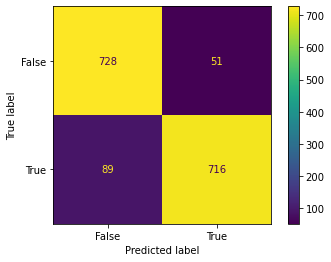A Machine Learning Model to Identify Fake Data from Social Media using Sentiment Features
Main Article Content
Abstract
The exponential growth in the use of social media is leading to sharing of information among each other through which the spreading of fake news is common these days. online social networking is the main source for fake news. The most popular social media are Twitter and Facebook, through which the majority of the news reaches the public. This study is aim to try different classification algorithms in comparing with Dataset. For our experiment purpose the dataset used is Real or Fake News dataset which is extracted from Kaggle, which comprises 30Mb of twitter data. The two major classification algorithms used are Naive Bayes and Logistic Regression classification algorithm. The algorithms result in Accuracy score 82.48%, AUC 1.0 and kappa score 0.64 and Accuracy score 91.16%, AUC 0.91 and kappa score 0.82 respectively for the given dataset. The two different classification algorithms are successfully checked with the given dataset. The sentimental analysis is the other way of identification of fake data problem which can be implemented to know the positive and negative sentiment in the given twits. VADER feature is the one of the feature extraction which can be tried with the dataset to find out fake and real data.
Article Details
References
W. Medhat , Hassan A, Korashy H (2014) Sentiment analysis algorithms and applications: a survey. Ain Shams Eng J. 5:1093–1113.
A. Abbasi, et al., "Selecting Attributes for Sentiment Classification Using Feature Relation Networks," IEEE Transactions on Knowledge and Data Engineering, vol. 23, pp. 447-462, 2011.
L. Mandloi and R. Patel, "Twitter Sentiments Analysis Using Machine Learninig Methods," 2020 International Conference for Emerging Technology(INCET), 2020, pp. 1-5, doi: 10.1109/INCET49848.2020.9154183
R. H. H. Aziz and N. Dimililer, "Twitter Sentiment Analysis using an Ensemble Weighted Majority Vote Classifier," 2020 International Conference on Advanced Science and Engineering (ICOASE), 2020, pp. 103-109, doi: 10.1109/ICOASE51841.2020.9436590
C. Catal, U. Sevim, and B. Diri, “Practical Development of an Eclipse-Based Software Fault Prediction Tool Using Naive Bayes Algorithm,” Expert Systems with Applications, vol. 38, pp. 2347- 2353, 2011
Prof. Bhushan Thakre, Dr. R.M Thakre. (2017). Analysis of Modified Current Controller and its Implementation in Automotive LED. International Journal of New Practices in Management and Engineering, 6(04), 01 - 06. https://doi.org/10.17762/ijnpme.v6i04.60
Sampurnanand Dwivedi, Vipul Singhal. (2023). A Study of Responsive Image Denoising Algorithm . International Journal of Intelligent Systems and Applications in Engineering, 11(3s), 286–291. Retrieved from https://ijisae.org/index.php/IJISAE/article/view/2686
M. Mhatre, D. Phondekar, P. Kadam, A. Chawathe, and K. Ghag, “Dimensionality reduction for sentiment analysis using pre-processing techniques,” 2017 International Conference on Computing Methodologies and Communication (ICCMC), pp. 16-21, 2017.
G. Chowdhary, “Natural Language Processing,” Annual Reviewof Information Science and Technology, vol. 37, no. 1, pp. 51-89 2020.
A. Blom and S. Thorsen, “Automatic Twitter replies with Python,” International conference “Dialog 2012”.
A. N. Rohman, E. Utami, and S. Raharjo, “Deteksi Kondisi Emosi pada Media Sosial Menggunakan Pendekatan Leksikon dan Natural Language Processing,” Eksplora Inform., vol. 9, no. 1, pp. 70-76, 2019
I. Riadi, S. Sunardi, and P. Widiandana, “Mobile Forensics for Cyberbullying Detection using Term Frequency - Inverse Document Frequency (TF-IDF),” J. Ilm. Tek. Elektro Komput. dan Inform., vol. 5, pp. 68-76, 2019.
A. Abbasi, et al., "Selecting Attributes for Sentiment Classification Using Feature Relation Networks," IEEE Transactions on Knowledge and Data Engineering, vol. 23, pp. 447-462,2011.
Peiman Barnaghi, John G. Breslin and Parsa Ghaffari, “Opinion Mining and Sentiment Polarity on Twitter and Correlation between Events and Sentiment”, 2016 IEEE Second International Conference on Big Data Computing Service and Applications.
A. Thota, P. Tilak, S. Ahluwalia, and N. Lohia, ‘‘Fake news detection: A deep learning approach,’’ SMU Data Sci. Rev., vol. 1, no. 3, p. 10, 2018.
Z. Jin, J. Cao, H. Guo, Y. Zhang, and J. Luo, ‘‘Multimodal fusion with recurrent neural networks for rumor detection on microblogs,’’ in Proc. 25th ACM Int. Conf. Multimedia, Oct. 2017, pp. 795–816.
S. M. Padnekar, G. S. Kumar, and P. Deepak, ‘‘BiLSTM-autoencoder architecture for stance prediction,’’ in Proc. Int. Conf. Data Sci. Eng. (ICDSE), Dec. 2020, pp. 1–5.
Abdullah-All-Tanvir, E. M. Mahir, S. Akhter, and M. R. Huq, ‘‘Detecting fake news using machine learning and deep learning algorithms,’’ in Proc. 7th Int. Conf. Smart Comput. Commun. (ICSCC), Jun. 2019, pp. 1–5.
Auma, G., Goldberg, R., Oliveira, A., Seo-joon, C., & Nakamura, E. Enhancing Sentiment Analysis Using Transfer Learning Techniques. Kuwait Journal of Machine Learning, 1(3). Retrieved from http://kuwaitjournals.com/index.php/kjml/article/view/129
R. R. Mandical, N. Mamatha, N. Shivakumar, R. Monica, and A. N. Krishna, ‘‘Identification of fake news using machine learning,’’ in Proc. IEEE Int. Conf. Electron., Comput. Commun. Technol. (CONECCT), Jul. 2020, pp. 1–6
R. K. Kaliyar, A. Goswami, P. Narang, and S. Sinha, ‘‘FNDNet— A deep convolutional neural network for fake news detection,’’ Cognit. Syst. Res., vol. 61, pp. 32–44, Jun. 2020. [Online]. Available: http://www.sciencedirect.com/science/article/pii/S1389041720300085
F. A. Ozbay and B. Alatas, ‘‘Fake news detection within online social media using supervised artificial intelligence algorithms,’’ Phys. A, Stat. Mech. Appl., vol. 540, Feb. 2020, Art. no. 123174.
H. Reddy, N. Raj, M. Gala, and A. Basava, ‘‘Text-mining-based fake news detection using ensemble methods,’’ Int. J. Autom. Comput., vol. 17, pp. 1–12, Apr. 2020.
K. Shu, S. Wang, and H. Liu, ‘‘Understanding user profiles on social media for fake news detection,’’ in Proc. IEEE Conf. Multimedia Inf. Process. Retr. (MIPR), Apr. 2018, pp. 430–435.
V. Bakir and A. McStay, “Fake News and The Economy of Emotions,” Digit. Journal., vol. 6, no. 2, pp. 154–175, 2017.
C. J. C. J. Hutto and E. Gilbert, “VADER: A Parsimonious Rule-Based Model for Sentiment Analysis of Social Media Text,” in ICWSM, 2014, no. May, pp. 216–225.
https://www.kaggle.com/code/yogeshpm/fake-or-real-news/input.

